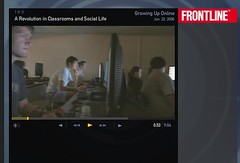Wanna know about Twitter?
The folks at Common Craft have done it again.
[kml_flashembed movie="http://www.youtube.com/v/ddO9idmax0o" width="425" height="350" wmode="transparent" /]
@Peace (in the twitterverse),
Kevin
This video was part of the site for the Learning 2.o Conference that was held last weekend in Colorado and co-organized by Bud the Teacher (who did a nice “braindump” — his term — podcast reflection of the event). I believe the video was created by The Fischbowl Blogger?
Interesting use of facts and hyperbole.
[kml_flashembed movie="http://video.google.com/googleplayer.swf?docid=-2855786550703993653" width="400" height="326" wmode="transparent" /]
Peace (in the end of writing … again),
Kevin
(This has been in the back seat of my blog for a month or so)
Curt Bonk is part of a group doing a research project on YouTube and they are looking for folks to take a survey. You can find more information about their work at Curt’s site (one incentive for folks who take the survey is to get 90-day trial of a survey machine called SurveyShare, which I have not heard of).
They have different categories, but here are the educational videos they have provided as part of their research analysis of why people create, share and comment on the web-based video systems:
. Did You know; Shift Happens – Globalization; Information Age
http://youtube.com/watch?v=ljbI-363A2Q
2. Did You Know 2.0
http://youtube.com/watch?v=pMcfrLYDm2U
3. Voices from the New American Schoolhouse (trailer)
http://youtube.com/watch?v=rgpuSo-GSfw
4. A Fair(y) Use Tale
http://youtube.com/watch?v=CJn_jC4FNDo
5. Pay Attention
http://youtube.com/watch?v=aEFKfXiCbLw
6. Wikis in Plain English
http://youtube.com/watch?v=-dnL00TdmLY
7. Video: RSS in Plain English
http://youtube.com/watch?v=0klgLsSxGsU
8. Education in Second Life: Explore the Possibilities
http://youtube.com/watch?v=TMGR9q43dag&mode=related&search
9. The Wire: Education
http://youtube.com/watch?v=XDg4U2jYXgw
(I have to include this one — The Wire is on the way out, but not in the DVD world)
[kml_flashembed movie="http://youtube.com/v/XDg4U2jYXgw" width="425" height="350" wmode="transparent" /]
(But if you want to see a troublesome virtual conversation, follow the comment links to this video on YouTube — this is why schools ban YouTube — racist remarks, profanity and lack of respect for other people)
10. Steve Jobs Stanford Commencement Speech 2005
http://youtube.com/watch?v=D1R-jKKp3NA
Peace (in viral videos),
Kevin
The Flat World is on my mind these days, as I just finished the book by Tom Friedman, and then I came across this trailer for a documentary about the emergence of math and science in China and India and, the concern about lack of these skills in the US, and the future for our children. Friedman makes the same point although he remains optimistic that our creativity and ingenuity will give us a competitive edge. He does warn that the increase in funds and government interest in technology-related fields in India and China, along with a lack of support here, could forebode some shifting of global power in the future.
Friedman calls on the next president to galvanize the country to invest in the future, through technology. We’ll see, won’t we?
[kml_flashembed movie="http://www.youtube.com/v/niU1E3SSTAM" width="425" height="350" wmode="transparent" /]
Education Week also profiled the documentary, which you can order as a DVD from the creators of Two Million Minutes (I did, because this idea of the world getting smaller and more competitive as technology comes into play both excited and worries me as a teacher and a parent).
And then there was the Frontline special this week — Growing Up Online — which I missed but found online via another blogger, Kate — and I have only watched the segment on education and technology/social networking in school environment. It was interesting and seemed fairly balanced between teachers and the pros and cons of using technology as a means of engagement of students. It was kind of depressing that one teacher feels she that is “outmoded” because she does not embrace technology and is not ready to give up the traditional classroom — discussions, reflection, writing.
It is disheartening when one boy says he never reads books anymore and uses only online activity as his “reading,” zipping through sites with summaries (such as Sparknotes). Then, in a moment of reflection, he admits that he is cheating himself (and blames lack of time). Also, the aspect of”collecting friends” in places such as MySpace and Facebook bubbles up and shows it for what is: just another social status tool and not what it should be: creating a sense of interconnected communities.

Peace (in smaller spaces),
Kevin

Bain News Service, publisher. [1911] [Germany Schaefer, Washington AL (baseball)]
The Library of Congress has now put thousands of photos from its archives up on Flickr for viewing and use by us, the people. This is a treasure trove of materials and I am already thinking of ways to use them in the classroom.
What is interesting is that the folks at the Library of Congress folks (see their blog) are opening up the door in Flickr for comments and tags by people. And they are using the “no known copyright” designation, too, which allows for more use by students, I think. Somebody in that federal office clearly gets it — the photos are going to be viewed and used.
My boys are going to love this: A flickr slideshow of photos of old baseball players.
Peace (in picturing history as it was),
Kevin
My youngest son was coughing in the night, so I am up early (even for me) and I find this link to a memory from my own childhood: Lite-Brite. Remember that one? All those little translucent pegs going into little slots with a back light and you make shapes and strange designs? (Or do you remember losing the little pegs or fumbing with your fat fingers to get them into the slots? That was me, too).
So of course, there is now an online version of Lite-Brite, and it is easy to use and fun way to kill some time in the morning when you should be sleeping.
As a kid, I created saxophones everywhere I went, so this is my morning Lite-Brite design:

And of course:

Peace (in colored pegs),
Kevin
I was bookmarking another Ning site the other day when I realized the exponential growth of my own Ning sites. 
Here is where I go :
That’s a lot of Ning-ing, even for me, but it is an interesting journey and the sense of community that I gain from each of these is very strong. There are deep discussions and sharing of ideas and, best of all, a very supportive and inviting environment.
Peace (in networks),
Kevin
Steve Hartegan, of Classroom 2,0, is at it again, compiling resources on how Ning and other social networks are being used in education. Here are some sample links from his new wiki site called Social Networks in Education:
Steve invites people to add their own links to the wiki, so if you are using social networks for education, go ahead and add the resource (I know I have at least one I have to put on the list under Professional Development)
Peace (in networks),
Kevin
Happy New Year!
Matt Needleman is re-launching his Video in the Classroom website and if you are interested in exploring this world with your students, this site is a good place to begin. Matt has pulled together examples, links and ideas on how to get started. The site is still under construction but it remains a place to visit and learn from.
(disclosure: Matt has profiled me and the work of my students at his site, including this podcast that Matt has put together with three teachers who do claymation in the classroom. The podcast is great and Matt gets at the inside of creating a clay movie with students in the classroom from a variety of viewpoints. I got some nice tips on using tinfoil on the inside of the clay figures to keep them from falling over — we call it the “melting” of the clay.).

Thanks, Matt, for sharing your resources with the rest of us. He is also launching a Blog Carnival and seeks your submissions for blog posts or articles related to video in the classroom.
Also, Matt is going to be this week’s host for the Day in a Sentence feature and more information about that will be coming tomorrow.
Peace (in sharing),
Kevin